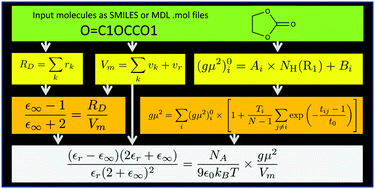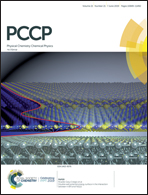Predicting dielectric constants of pure liquids: fragment-based Kirkwood–Fröhlich model applicable over a wide range of polarity†
Abstract
In view of developing a procedure to predict the dielectric constant (εr) of pure liquids from molecular structure, a thorough analysis of prominent factors affecting this property is carried out. The results suggest that the orientational dipolar parameter gμ2 involved in the Kirkwood–Fröhlich theory may be estimated as a sum of additive contributions (gμ2)i associated with suitably defined polar fragments i. Associated with third-party models for the molar volume Vm and the refractive index nD, this provides a practical route to predicting εr for new compounds. Advantages over previous methods include: simplicity, as the present model relies on fragment-additivity and does not require 3D structures; sound physical bases; demonstrated applicability to polar liquids with εr values up to 200; predictive ability extensively demonstrated against large datasets (for a total of 1220 compounds) covering a broad structural diversity, resulting in values of the root mean square deviation/average percent error as low as 3.7/10% for data sets focused on simple organic compounds as considered in previous studies, although the inclusion of many alcohols in the data set leads to poorer statistics (5.0/32%) due to the lack of specific parameters for hydroxyl groups in distinct environments. The approach should be of special interest in the current search for new aprotic electrolytes aimed at improving the performances of electrochemical energy storage systems. Although its reliance on many fitting parameters restricts its domain of applicability, the present implementation is recommended over current procedures whenever possible. A Python script is provided to allow its straightforward application.



 Please wait while we load your content...
Please wait while we load your content...